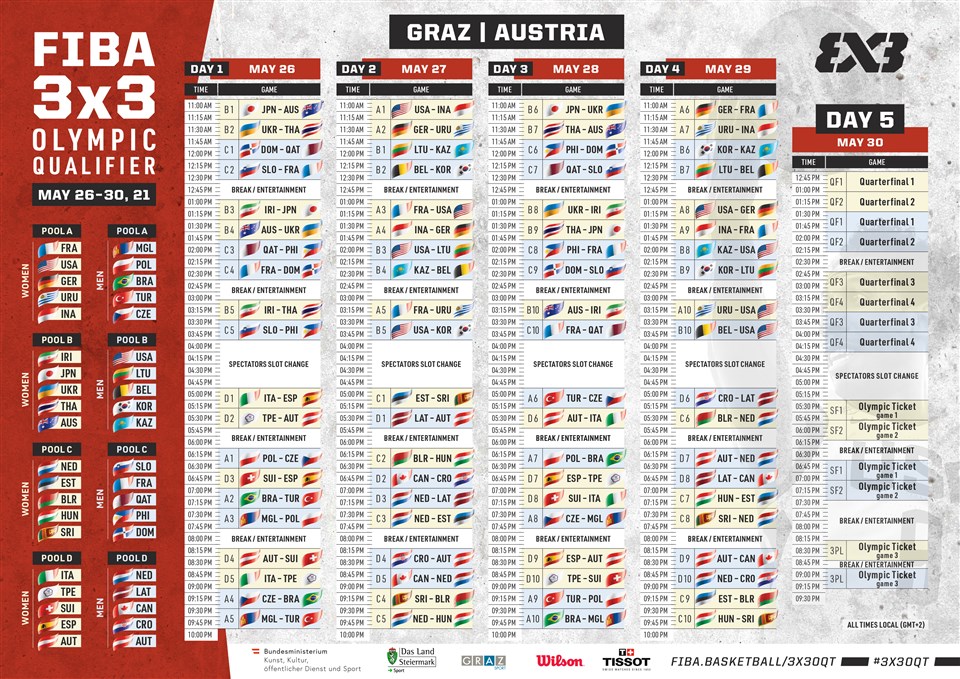History of Basketball at the Summer Olympics: Basketball At The Summer Olympics Schedule

Basketball’s journey at the Summer Olympics is a story of growth, innovation, and global dominance. From its humble beginnings as a demonstration sport to its current status as a cornerstone of the Games, basketball has evolved significantly, leaving an indelible mark on the sporting landscape.
Early Years and Demonstration Sport
Basketball’s introduction to the Olympics was gradual. The sport was first showcased as a demonstration sport at the 1904 Summer Olympics in St. Louis, Missouri. While not an official medal event, it served as an early glimpse of basketball’s potential on the international stage.
Official Inclusion and the Rise of the United States
The year 1936 marked a turning point for basketball at the Olympics. The sport was officially included in the Summer Olympics in Berlin, with men’s teams competing for the coveted gold medal. The United States, with its strong basketball tradition, emerged as a dominant force, winning the inaugural tournament.
The Evolution of Rules and Format
Basketball at the Olympics has undergone several rule changes and format modifications over the years. The early years saw a focus on amateurism, with professional players excluded from participation. This restriction was lifted in 1992, ushering in a new era of professional dominance.
Notable Players and Teams
The history of basketball at the Olympics is replete with legendary players and teams who have left an unforgettable legacy. Michael Jordan’s “Dream Team” in 1992, featuring NBA superstars like Magic Johnson, Larry Bird, and Charles Barkley, is widely regarded as the greatest Olympic basketball team of all time.
Women’s Basketball Joins the Games
The inclusion of women’s basketball at the 1976 Summer Olympics in Montreal marked a significant milestone for the sport. The United States, once again, dominated the competition, winning the inaugural gold medal.
Timeline of Basketball at the Summer Olympics
- 1904: Basketball is featured as a demonstration sport at the St. Louis Summer Olympics.
- 1936: Basketball becomes an official medal event at the Berlin Summer Olympics, with the United States winning the men’s gold medal.
- 1976: Women’s basketball is included in the Montreal Summer Olympics, with the United States claiming the gold medal.
- 1992: Professional players are allowed to participate in the Barcelona Summer Olympics, leading to the formation of the legendary “Dream Team.”
Competition Format and Structure

The Olympic basketball tournament is a highly competitive event featuring some of the best players in the world. It follows a specific format that ensures exciting matches and a fair chance for all participating teams to showcase their skills.
Olympic Basketball Tournament Format, Basketball at the summer olympics schedule
The Olympic basketball tournament features 12 teams competing for the coveted gold medal. The qualification process for the tournament involves a series of continental and global tournaments, where teams strive to secure one of the coveted spots. Once qualified, the teams are divided into three groups of four during the group stage.
- Group Stage: Teams within each group play each other once, with the top two teams from each group advancing to the knockout stage.
- Knockout Stage: The knockout stage consists of a series of single-elimination matches, where the loser is eliminated from the tournament. The winners of the quarter-finals advance to the semi-finals, and the winners of the semi-finals compete for the gold medal in the final. The losers of the semi-finals play for the bronze medal.
Rules and Regulations
The rules of Olympic basketball are largely based on the rules of the National Basketball Association (NBA), with some key differences:
- Time Limits: Olympic basketball games are played in four quarters of 10 minutes each, compared to four quarters of 12 minutes in the NBA.
- Foul Limits: Players are allowed five fouls in an Olympic game, while NBA players have six fouls.
- Three-Point Line: The three-point line in Olympic basketball is slightly shorter than in the NBA, making it easier to score from beyond the arc.
- Technical Fouls: Technical fouls are called for unsportsmanlike conduct, such as arguing with officials or taunting opponents.
Tournament Phases
The following table summarizes the different phases of the Olympic basketball tournament, outlining the number of teams participating and the qualification criteria for each phase:
| Phase | Number of Teams | Qualification Criteria |
|---|---|---|
| Group Stage | 12 | Top two teams from each group advance to the knockout stage. |
| Knockout Stage | 8 | Winners of the quarter-finals advance to the semi-finals. |
| Semi-Finals | 4 | Winners of the semi-finals compete for the gold medal. |
| Final | 2 | Winners of the semi-finals compete for the gold medal. |
Notable Teams and Players

The Summer Olympics have witnessed the rise of legendary basketball teams and players who have left an indelible mark on the sport. From the dominant forces of the United States to the emergence of international powerhouses, the Olympic stage has provided a platform for showcasing exceptional talent and fostering global competition.
Dominant Teams and Players
The United States has been the most dominant force in Olympic basketball, having won 16 gold medals out of 19 tournaments. Their dominance can be attributed to the consistent presence of NBA superstars, who bring a wealth of experience and skill to the international stage.
The “Dream Team” of 1992, featuring iconic players like Michael Jordan, Magic Johnson, Larry Bird, and Charles Barkley, is widely considered the greatest basketball team ever assembled. This team revolutionized the game and ushered in a new era of global interest in the sport.
The United States has also produced numerous legendary players who have left their mark on Olympic basketball. Michael Jordan, with his unmatched talent and competitive spirit, is considered the greatest basketball player of all time. LeBron James, another NBA superstar, has consistently led the United States to victory, demonstrating his versatility and leadership on the court.
Challenges and Opportunities
While the United States has enjoyed unparalleled success, other countries have faced challenges in competing at the highest level. Limited access to professional leagues and financial resources can hinder the development of talent and limit international competitiveness.
However, the growth of international basketball leagues and the increasing popularity of the sport globally present opportunities for other nations to close the gap. Teams from Spain, Argentina, France, and Australia have emerged as formidable contenders, showcasing their talent and tactical prowess on the world stage.
Top 5 Most Successful Olympic Basketball Teams
The following list highlights the top 5 most successful Olympic basketball teams, based on their medal counts and key players:
- United States: 16 Gold, 1 Silver, 0 Bronze – Michael Jordan, LeBron James, Kobe Bryant, Magic Johnson, Larry Bird, Kareem Abdul-Jabbar
- Soviet Union: 2 Gold, 4 Silver, 2 Bronze – Alexander Belov, Sergei Belov, Vladimir Tkachenko
- Spain: 1 Silver, 1 Bronze – Pau Gasol, Juan Carlos Navarro, Marc Gasol
- Argentina: 1 Gold, 1 Silver, 0 Bronze – Manu Ginobili, Luis Scola, Andrés Nocioni
- Lithuania: 0 Gold, 1 Silver, 1 Bronze – Arvydas Sabonis, Šarūnas Marčiulionis, Žydrūnas Ilgauskas
Basketball at the summer olympics schedule – The basketball schedule at the Summer Olympics is packed with intense matches, showcasing the world’s best players. If you can’t be there in person, you can catch all the action with an olympics live stream , bringing the excitement directly to your screen.
Don’t miss the thrilling competition as teams battle for Olympic glory, with every shot, pass, and rebound counting towards the ultimate prize.
The basketball schedule at the Summer Olympics is always a highlight, with teams from around the world vying for gold. One of the most anticipated matchups is often Serbia vs. USA basketball , a rivalry that has produced some of the most exciting and competitive games in recent Olympic history.
These two teams have a long history of battling it out on the court, and their matches are always sure to be intense and captivating. As the games progress, the schedule becomes even more thrilling, with each victory bringing a team closer to the coveted gold medal.
